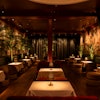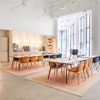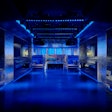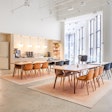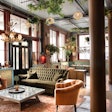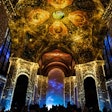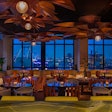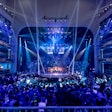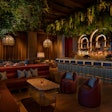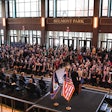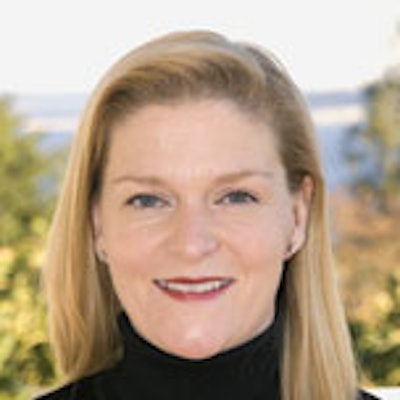
Photo: Jeffrey Rosenfeld
Holly Rosenfeld
Title: Brand strategy manager, Starbucks Corporation
What She Does: Starbucks has an event group that handles corporate shareholder meetings and other events, but Rosenfeld works on another team charged with corporate advertising and brand strategy. That gives her domain over largescale events that shape the company’s brand. This year, she developed a temporary experience called the Starbucks Salon, which Starbucks bills as “a nomadic, interactive coffeehouse, gallery, and performance venue rolled into one.” The concept premiered at the Sundance Film Festival and came to New York for 10 days in September, where it brought 30 performers and roughly 5,600 customers to a retail space in SoHo. Next up: taking the Salon concept abroad.
Staff: Works in a team of three and gets help from other departments.
Age: 40
Career Path: After getting a bachelor of arts in business administration at the University of Washington, she worked at a small event planning company in Seattle in the early 90’s. She then moved into marketing, PR, and advertising at a Seattle advertising agency, where Starbucks was a client. Next, she joined Microsoft as channel marketing manager. She started working at Starbucks in 2002, first as a consultant for a year and then full-time.
Where She Lives: Seward Park, “one of the more multicultural neighborhoods in Seattle.”
Where She Grew Up: Saudi Arabia. “My father worked for a defense contractor. We were a middle class family with four kids and parents who wanted us to travel and see the world, which they couldn’t afford to do from here.”
Favorite Drink: Decaf-tripletall Americano, with room for cream What was the genesis of the Starbucks Salon?
It started about two years ago when we were in the process of pulling together ideas around a comprehensive brand strategy. It came out of multiple brainstorming sessions: What are the things we want to bring to our customer that extend the Starbucks experience? We didn’t want to just put something out there for customers to see; we wanted to give them something they had an opportunity to interact with and take something away from.
How did you incorporate those goals into the look and feel of the salons?
One of the strategies was to make it new and interesting and experiential. Obviously, there was a full-functioning Starbucks bar, but the goal was to create a visually interesting space. We wanted it to convey an element of discovery. We had New York artist Romon “Rostarr” Yang create a huge mural as a backdrop. We incorporated a basement gallery that displayed work from local artists. The presentation of the art itself was unique; the work was displayed on this slanted, crazy-shaped wall. And we decorated the space upstairs with portraits of our customers; using the drawing tools on our Web site, customers could create self-portraits, which we printed and hung on the walls. We actually received 750 submissions, and people continue to submit them.
Our primary criteria for our performers was that they had to be emerging; if someone was more established, they had to be doing something different than the mainstream talent. For furniture, we wanted a juxtaposition of the coffee shop of today with an old-world café, which was all about people gathering and artists sharing. So we mixed modern with vintage. The overall idea was to make it feel like a Starbucks, but at the same time stepping outside what a traditional Starbucks is.
How did you decide on 76 Greene Street for your location?
We hit the streets, working with different people in the real estate business, to find open storefronts. SoHo has a reputation for being an artists’ community [and] the overall environment felt right. The street itself wasn’t a main street like Broadway. The idea was about people seeking out and discovering it, rather than being in the most high-profile, high-traffic spot.
The event overlapped with September 11. Was that intentional?
In picking locations, we were looking for cities that are destinations in and of themselves or cities that have some world gathering type of event. One of the reasons we wanted to be in New York during this time frame was because Fashion Week was happening—it wasn’t like we were trying to be in New York on September 11. That said, we didn’t just want to do another day of scheduled performances. So we had a day of curated short films and musical ensembles that paid homage to New York City.
How did you measure ROI for this event?
As any brand program goes, measuring ROI is extremely difficult because a lot of it is a long-term play. But one of the things we looked at was the level of public relations and buzz we were able to garner. On both levels, we felt the program was very successful.
We got national coverage and mentions in the local media, and we got a ton of online and blog mentions. We were all based in SoHo during the event, and there were several instances where [our] people would be in different stores or restaurants around the location and hear people talking about it.
When you sold the idea to senior management, did they have reservations?
Nothing jumps to mind, except it isn’t cheap to put something like this on. The way we were able to sell it was by communicating as highly and as broadly as we could. It’s important to evangelize ideas throughout the company—the more people who know about it and are excited about it, the better. It’s sort of the same concept as the buzz that gets built externally, but it’s the buzz that builds inside the company.
Looking back, one of the things that was extremely helpful was incorporating some type of live element into our presentations to senior management. Even before we had dates for Sundance [where the concept premiered earlier this year] and New York, we created a video montage that communicated our vision of extending the Starbucks experience in a way that provides customers with a sense of discovery and fosters a human connection. The montage represented the tone of Salon, which feels very much like Starbucks, but pushes boundaries with a more modern feel.
New Yorkers have very high expectations when it comes to their culture. How did you go about meeting them?
One of the overarching pieces of Salon is that we wanted it to feel very authentic to the city we were in, so it wasn’t like, “Hey, New Yorkers, you usually expect things that way, but we’re going to do it this way.” We relied heavily on our New York marketing team, and on Gen Art’s expertise [to procure performers] and Edelman’s expertise [to handle PR]. And we assembled a curatorial board to get a sense of how we could make the event interesting. We used traditional forms of marketing, but tried to do it in a unique way; our advertising incorporated portraits of the artists, so there was a nice continuity between the portrait project and how we communicated the event. We also put feet on the street and had people in the SoHo area handing out information and talking to local merchants and people in the neighborhood.
What do you think brought New Yorkers out?
People were hugely intrigued by the temporary location—one day it’s an empty storefront and the next day it’s an amazing event space. I do think the performances did a lot to bring folks in. New Yorkers are also very cynical. Were you worried that your interest in the local arts scene would come across as nothing more than a ploy to sell more coffee? The goal of this program was not some big corporate ploy, [the goal was] to integrate us into that scene and provide a performance venue to emerging artists. We believed that if we demonstrate that objective and become an authentic member of that community, we’d win people over.
—Michele Marchetti
Title: Brand strategy manager, Starbucks Corporation
What She Does: Starbucks has an event group that handles corporate shareholder meetings and other events, but Rosenfeld works on another team charged with corporate advertising and brand strategy. That gives her domain over largescale events that shape the company’s brand. This year, she developed a temporary experience called the Starbucks Salon, which Starbucks bills as “a nomadic, interactive coffeehouse, gallery, and performance venue rolled into one.” The concept premiered at the Sundance Film Festival and came to New York for 10 days in September, where it brought 30 performers and roughly 5,600 customers to a retail space in SoHo. Next up: taking the Salon concept abroad.
Staff: Works in a team of three and gets help from other departments.
Age: 40
Career Path: After getting a bachelor of arts in business administration at the University of Washington, she worked at a small event planning company in Seattle in the early 90’s. She then moved into marketing, PR, and advertising at a Seattle advertising agency, where Starbucks was a client. Next, she joined Microsoft as channel marketing manager. She started working at Starbucks in 2002, first as a consultant for a year and then full-time.
Where She Lives: Seward Park, “one of the more multicultural neighborhoods in Seattle.”
Where She Grew Up: Saudi Arabia. “My father worked for a defense contractor. We were a middle class family with four kids and parents who wanted us to travel and see the world, which they couldn’t afford to do from here.”
Favorite Drink: Decaf-tripletall Americano, with room for cream What was the genesis of the Starbucks Salon?
It started about two years ago when we were in the process of pulling together ideas around a comprehensive brand strategy. It came out of multiple brainstorming sessions: What are the things we want to bring to our customer that extend the Starbucks experience? We didn’t want to just put something out there for customers to see; we wanted to give them something they had an opportunity to interact with and take something away from.
How did you incorporate those goals into the look and feel of the salons?
One of the strategies was to make it new and interesting and experiential. Obviously, there was a full-functioning Starbucks bar, but the goal was to create a visually interesting space. We wanted it to convey an element of discovery. We had New York artist Romon “Rostarr” Yang create a huge mural as a backdrop. We incorporated a basement gallery that displayed work from local artists. The presentation of the art itself was unique; the work was displayed on this slanted, crazy-shaped wall. And we decorated the space upstairs with portraits of our customers; using the drawing tools on our Web site, customers could create self-portraits, which we printed and hung on the walls. We actually received 750 submissions, and people continue to submit them.
Our primary criteria for our performers was that they had to be emerging; if someone was more established, they had to be doing something different than the mainstream talent. For furniture, we wanted a juxtaposition of the coffee shop of today with an old-world café, which was all about people gathering and artists sharing. So we mixed modern with vintage. The overall idea was to make it feel like a Starbucks, but at the same time stepping outside what a traditional Starbucks is.
How did you decide on 76 Greene Street for your location?
We hit the streets, working with different people in the real estate business, to find open storefronts. SoHo has a reputation for being an artists’ community [and] the overall environment felt right. The street itself wasn’t a main street like Broadway. The idea was about people seeking out and discovering it, rather than being in the most high-profile, high-traffic spot.
The event overlapped with September 11. Was that intentional?
In picking locations, we were looking for cities that are destinations in and of themselves or cities that have some world gathering type of event. One of the reasons we wanted to be in New York during this time frame was because Fashion Week was happening—it wasn’t like we were trying to be in New York on September 11. That said, we didn’t just want to do another day of scheduled performances. So we had a day of curated short films and musical ensembles that paid homage to New York City.
How did you measure ROI for this event?
As any brand program goes, measuring ROI is extremely difficult because a lot of it is a long-term play. But one of the things we looked at was the level of public relations and buzz we were able to garner. On both levels, we felt the program was very successful.
We got national coverage and mentions in the local media, and we got a ton of online and blog mentions. We were all based in SoHo during the event, and there were several instances where [our] people would be in different stores or restaurants around the location and hear people talking about it.
When you sold the idea to senior management, did they have reservations?
Nothing jumps to mind, except it isn’t cheap to put something like this on. The way we were able to sell it was by communicating as highly and as broadly as we could. It’s important to evangelize ideas throughout the company—the more people who know about it and are excited about it, the better. It’s sort of the same concept as the buzz that gets built externally, but it’s the buzz that builds inside the company.
Looking back, one of the things that was extremely helpful was incorporating some type of live element into our presentations to senior management. Even before we had dates for Sundance [where the concept premiered earlier this year] and New York, we created a video montage that communicated our vision of extending the Starbucks experience in a way that provides customers with a sense of discovery and fosters a human connection. The montage represented the tone of Salon, which feels very much like Starbucks, but pushes boundaries with a more modern feel.
New Yorkers have very high expectations when it comes to their culture. How did you go about meeting them?
One of the overarching pieces of Salon is that we wanted it to feel very authentic to the city we were in, so it wasn’t like, “Hey, New Yorkers, you usually expect things that way, but we’re going to do it this way.” We relied heavily on our New York marketing team, and on Gen Art’s expertise [to procure performers] and Edelman’s expertise [to handle PR]. And we assembled a curatorial board to get a sense of how we could make the event interesting. We used traditional forms of marketing, but tried to do it in a unique way; our advertising incorporated portraits of the artists, so there was a nice continuity between the portrait project and how we communicated the event. We also put feet on the street and had people in the SoHo area handing out information and talking to local merchants and people in the neighborhood.
What do you think brought New Yorkers out?
People were hugely intrigued by the temporary location—one day it’s an empty storefront and the next day it’s an amazing event space. I do think the performances did a lot to bring folks in. New Yorkers are also very cynical. Were you worried that your interest in the local arts scene would come across as nothing more than a ploy to sell more coffee? The goal of this program was not some big corporate ploy, [the goal was] to integrate us into that scene and provide a performance venue to emerging artists. We believed that if we demonstrate that objective and become an authentic member of that community, we’d win people over.
—Michele Marchetti


